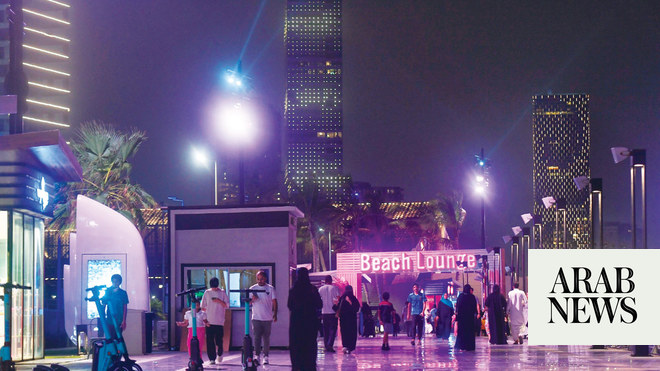The Saudi government's efforts to diversify the economy away from oil and promote private sector growth are showing progress across four dimensions: exports, output, government revenue, and employment, although oil remains a dominant force in the economy.
Saudi Arabia's Vision 2030 plan aims to transform the economy, improve citizens' lives, and maintain global prominence through ambitious projects like Neom's $1 trillion megacity known as The Line, but the success of the plan is uncertain and could pose challenges in terms of social tensions and regional competition.
Saudi Arabia's Tadawul All Share Index has experienced a significant decline due to poor performance from larger listed companies in sectors such as banking, energy, and materials, while stocks outside of these sectors have boosted the index; however, analysts believe the market to be fundamentally strong and see selloffs as buying opportunities due to transformative reforms and incentives implemented by Saudi Arabia under the Vision 2030 program.
Saudi Arabia experienced a sharp decline in its foreign reserves, with a drop of over $16 billion last month, marking the largest decrease since the negative oil prices during the pandemic as the country invested in US stocks using its savings.
Saudi Arabia, as a new member of the BRICS economic alliance, plans to invest $16 billion from its foreign reserves, signaling a shift towards prioritizing investment over reserves and potentially bolstering the bloc's ongoing initiatives.
Saudi Arabia's tourism revenue tripled in the first quarter of 2023 as the country attracted more visitors and sought to diversify its economy from oil, with a surplus of 22.8 billion Saudi riyals ($9.86 billion) in the balance of payments for the tourism sector and a record number of tourists.
Kuwait has appointed Fahd Al-Jarallah as the new finance minister, replacing Manaf Al Hajeri who resigned in July, while Saudi Arabia's Tadawul All Share Index closed 35.42 points lower on Sunday, and Saudi Arabia has exempted micro and small businesses with annual revenues below $2.7 million from auditor's requirements to support entrepreneurship in the country. In other news, Oman's refineries and petroleum industries reported a 13.5% growth in July, and Jeddah will host an event and conference on elevators and escalator technologies in September, contributing to the growth of the vertical transportation industry in Saudi Arabia. Additionally, Qatar's tourism sector continues to thrive, with a 91.4% year-on-year increase in visitors in July, and container shipments handled by Qatari ports saw a 19% surge in August.
Saudi Arabia plans to invest up to $25 billion in Pakistan over the next few years, focusing on sectors such as mining, agriculture, and information technology, in an effort to increase foreign direct investment and aid Pakistan's economic recovery.
The U.S. economy is heading towards a soft landing, but the actions of Saudi Arabia and Russia may disrupt this trajectory.
Pakistan's civilian and military leaderships are optimistic that Gulf states, particularly Saudi Arabia, will invest billions of dollars in the country to alleviate its cost-of-living crisis, but doubts remain about the feasibility of these projections and the need for economic reforms and stability.
The Saudi fashion industry is projected to have the highest growth rates among large, high-income markets, with fashion sales expected to surge by 48% from 2021 to 2025, according to a report by the Saudi Fashion Commission. The industry contributed 1.4% to the country's GDP in 2022 and is expected to reach a turnover of $32 billion by 2026. The report also highlights the sector's contribution to job creation and the push for inclusivity, with women making up 52% of employees in the fashion sector.
Analysts predict that Saudi Arabia may face an economic contraction in 2023 due to its decision to extend crude production cuts, highlighting the nation's heavy reliance on oil, while a large dividend from Saudi Aramco may provide some cushion for public finances.
Saudi Arabia is set to increase its crude supplies to China as new refining capacity lifts offtake, aiming to regain lost market share in the country. Meanwhile, China's huge zinc imports have revived hopes for economic growth in the second half of 2023.
Saudi Arabia's membership in the G20 is a reflection of its growing importance in global energy exports, international trade, and financial resources, as well as its impact on the global economy and its commitment to stability and development.
Pakistan needs to address concerns related to incentives, coordination, and remittance in order to secure Saudi investments in copper, mineral, refinery, and solar projects worth $25-30 billion, including the construction of a $10-12 billion refinery in Hub or Gwadar.
Saudi Arabia is undergoing a major transformation through its Vision 2030 plan, led by Crown Prince Mohammed Bin Salman, aiming to diversify its economy and secure its place on the global stage; despite controversies and challenges, the country's economy is booming, heavily reliant on oil, and is making significant investments at home and abroad.
Saudi Arabia is actively seeking to exchange experience with nations worldwide to achieve carbon neutrality by 2060 and ensure sustainable development, with a focus on economic, social, and environmental sustainability.
Saudi Arabia's debt market is set to be reformed in order to help businesses in the Kingdom acquire funding and compete on a global level, according to the chairman of the Capital Markets Authority. The changes will occur gradually to ensure economic stability and support the goals of the Vision 2030 initiative to grow the country's financial sector. The chairman also expressed optimism about the growth of the Saudi Stock Exchange and its record-breaking performance in 2022.
The United States is in regular contact with Saudi Arabia to ensure a stable and affordable supply of energy to global markets, according to National Security Advisor Jake Sullivan. This comes as cuts in oil output by Saudi Arabia and Russia are expected to result in a significant market deficit.
